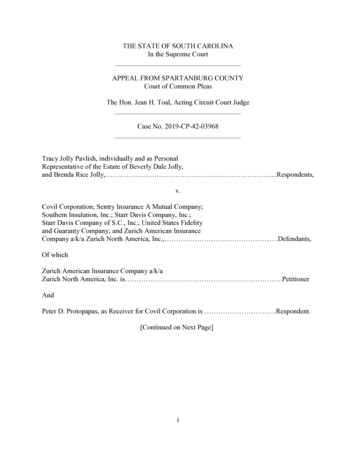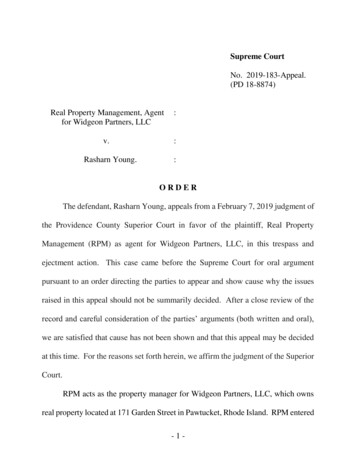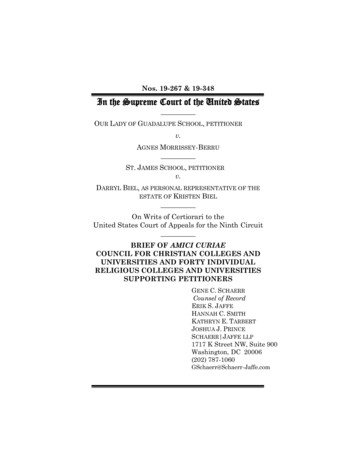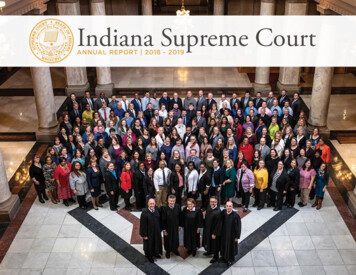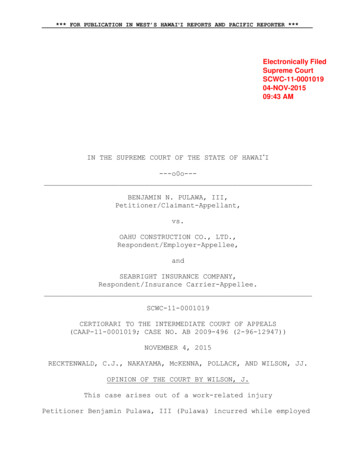
Transcription
*** FOR PUBLICATION IN WEST’S HAWAIʻI REPORTS AND PACIFIC REPORTER ***Electronically FiledSupreme CourtSCWC-11-000101904-NOV-201509:43 AMIN THE SUPREME COURT OF THE STATE OF HAWAI I---o0o--BENJAMIN N. PULAWA, III,Petitioner/Claimant-Appellant,vs.OAHU CONSTRUCTION CO., LTD.,Respondent/Employer-Appellee,andSEABRIGHT INSURANCE COMPANY,Respondent/Insurance Carrier-Appellee.SCWC-11-0001019CERTIORARI TO THE INTERMEDIATE COURT OF APPEALS(CAAP-11-0001019; CASE NO. AB 2009-496 (2-96-12947))NOVEMBER 4, 2015RECKTENWALD, C.J., NAKAYAMA, McKENNA, POLLACK, AND WILSON, JJ.OPINION OF THE COURT BY WILSON, J.This case arises out of a work-related injuryPetitioner Benjamin Pulawa, III (Pulawa) incurred while employed
*** FOR PUBLICATION IN WEST’S HAWAIʻI REPORTS AND PACIFIC REPORTER ***as a construction supervisor for Oahu Construction Co., Ltd.(Oahu Construction) and the subsequent workers’ compensationclaims made against Oahu Construction, insured by SeabrightInsurance Company.The issues presented on appeal are 1)whether there was substantial evidence to show that aneuromonics device was reasonably needed to treat Pulawa’stinnitus and 2) whether Pulawa was no longer entitled to totaltemporary disability (TTD) payments because he was able toresume work.We hold that there was substantial evidence thatthe neuromonics device was reasonably needed for treatingPulawa’s tinnitus, and that based on this finding, Pulawa wasnot medically stable and unable to return to work.Thus, theLabor and Industrial Relations Appeals Board (LIRAB) clearlyerred in its determination that Pulawa was not entitled to theneuromonics device and in its decision to terminate Pulawa’s TTDpayments.Accordingly, the Intermediate Court of Appeals’ (ICA)December 16, 2014 Judgment on Appeal and LIRAB’s November 2,2011 Decision and Order are vacated.The case is remanded toLIRAB for proceedings consistent with this opinion.I.A.BackgroundPulawa’s Work-Related AccidentPulawa’s tinnitus diagnosis is due to a work-relatedaccident.On August 20, 1996, Pulawa was employed by Oahu2
*** FOR PUBLICATION IN WEST’S HAWAIʻI REPORTS AND PACIFIC REPORTER ***Construction as a construction supervisor when he was injured.As he was observing the construction operations, Pulawa wasstruck in the head by a 12 inch by 6 inch rock that becameairborne after being run over by a loader vehicle.The forcefrom this projectile cracked Pulawa’s hard hat and fractured hisskull.1As a result of this accident, Pulawa now suffers severeheadaches, tinnitus, and depression.Tinnitus sufferers hearringing or other sounds in the ear when no external sound ispresent.See 11 Roscoe N. Gray & Louise J. Gordy, Attorneys’Textbook of Medicine ¶ 84.63 (3d ed. 2014).Pulawa suffers fromchronic bilateral tinnitus, which is described as a “constant,high-pitched tone.”Pulawa has not returned to work since hewas injured in August 1996.B.Pulawa’s Medical Treatment and Doctor EvaluationsImmediately after the accident, Pulawa was treated atThe Queen’s Medical Center and required surgery to repair a leftfrontal skull depressed fracture.As he recovered from surgery,Pulawa suffered from impaired cognitive functions.After morethan two weeks of hospitalization, Pulawa was transferred to theRehabilitation Hospital of the Pacific for another two weeks,where he received physical, occupational, and speech therapy.1Pulawa sued the landowner and other parties involved fornegligence, but he did not prevail. Pulawa v. GTE Hawaiian Tel, 112 Hawai i3, 7-8, 143 P.3d 1205, 1209-10 (2006).3
*** FOR PUBLICATION IN WEST’S HAWAIʻI REPORTS AND PACIFIC REPORTER ***After his release from the Rehabilitation Hospital, Pulawacontinued outpatient therapy on a monthly basis forapproximately two years.His primary complaints consisted ofheadaches, cognitive issues, and sleep problems.While earlyreports do not specifically list tinnitus as a complaint, he wasbriefly prescribed tinnitus medication (amitriptyline) in 1997and also complained of ringing in his ears during an independentneuropsychological evaluation performed in 2000.Pulawa has been continuously treated for his ailments—primarily headaches and tinnitus—from the time of the accident.Dr. Barry Odegaard, Pulawa’s family physician, treated Pulawafrom 1997 to approximately 2001.Dr. Robert Marvit, apsychiatrist, treated Pulawa from early 2001 to late 2009, whenhe retired.In 2001, Dr. Marvit prescribed a treatment planthat consisted of Pulawa attending the Casa Colina Center ofRehabilitation (Casa Colina), a residential brain injurytreatment program in Pomona, California, for several months.2Dr. Marvit believed that the residential treatment program wouldallow Pulawa to maximize his capacities so that he would be2Dr. Marvit’s status as an attending or concurrent physician underHawai i Administrative Rules (HAR) § 12-15-32 or § 12-15-40, which is requiredto submit a treatment plan, was challenged by Oahu Construction.Subsequently, Dr. Marvit was found to be a concurrent physician by theDirector of the Department of Labor and Industrial Relations. However,further challenges to Dr. Marvit’s treatment plan, including attendance inthe Casa Colina treatment program, were brought by Oahu Construction.4
*** FOR PUBLICATION IN WEST’S HAWAIʻI REPORTS AND PACIFIC REPORTER ***“functionally capable of returning to useful, gainful activity.”Dr. Marvit noted that the program “would also include lessreliance on medication, increased interpersonal, positiveinteractions, avoidance of self-destructive behaviors, paincontrol, and an exercise of his vocational potential.”Dr. David Patterson, the Medical Director at CasaColina, stated in his preadmission screening report that Pulawawas an acceptable candidate for the brain injury treatmentprogram, even though Pulawa had some “psychological overlay”that was preventing further recovery.Despite thispsychological hindrance, Dr. Patterson believed that Pulawa hadpersistent physical and neurocognitive symptoms, such astinnitus, that needed to be addressed.Proposed treatmentincluded admission to Casa Colina’s comprehensiveneuropsychological program that would provide Pulawa with“compensatory strategies to deal with the emotional, cognitiveand psychological difficulties.”In addition, Dr. Pattersonrecommended cervical trigger point injections to promotemovement in the neck, an evaluation of his migraine-typemedications, and evaluations by specialists in otology,neurology, audiology, oral/maxillofacial, and neuro-optometry tofurther his recovery.Pulawa agreed to attend the treatmentprogram.5
*** FOR PUBLICATION IN WEST’S HAWAIʻI REPORTS AND PACIFIC REPORTER ***However, admission to Casa Colina was delayed fornearly six years due to Oahu Construction’s challenge of Dr.Marvit’s treatment plan recommending admission.After theDirector of the Department of Labor and Industrial Relations,Disability Compensation Division (Director) approved thetreatment plan and LIRAB affirmed the Director’s decision,Pulawa attended Casa Colina, where he participated in theprogram from September 2007 to February 2008.During the treatment program, Pulawa received severaltreatments to manage and relieve his headaches, tinnitus, anddepression.Relevant to this appeal, Dr. Lucy Shih, aspecialist in otology and neurotology at the Casa Colina center,examined Pulawa and recommended that he be fitted with aneuromonics device, a device that at the time was only availableat the House Ear Institute in Los Angeles, California.Dr. Shihwas referred by Dr. Patterson specifically to assess treatmentoptions for Pulawa’s tinnitus symptoms.Dr. Shih stated in aletter to Dr. Patterson that she informed Pulawa of “arelatively new tinnitus treatment which may be beneficial.”Dr.Shih described the device as “a listening device manufactured byNeuromonics which incorporates a neural stimulus into music tointerrupt and desensitize the brain from continued perception of[tinnitus].”The device consists of earphones connected to a6
*** FOR PUBLICATION IN WEST’S HAWAIʻI REPORTS AND PACIFIC REPORTER ***small compact music player.Dr. Patterson agreed with Dr.Shih’s recommendation to fit Pulawa with a neuromonics device.However, Pulawa was released from Casa Colina after five monthsof treatment, returning to Hawai i in February 2008, withoutbeing fitted for the neuromonic device.3Rather than authorizing the neuromonics device afterPulawa completed the Casa Colina program, Oahu Constructionrequested two independent evaluations by Drs. Brian Goodyear, aneuropsychologist, and Anthony Mauro, a neurologist, as well asa vocational rehabilitation assessment, to update Pulawa’sworkers’ compensation disability status.1.Dr. Brian Goodyear’s Supplemental IndependentPsychological EvaluationDr. Goodyear, a neuropsychologist, evaluated Pulawa onMay 23, 2008 and May 27, 2008 after Pulawa sought authorizationfrom Oahu Construction for the neuromonics device that he hadnot received during his treatment in California.Although Dr.Goodyear concluded Pulawa was medically stable and thereforewould not improve with future treatment, he did not discuss theutility of the neuromonics device in his report; nor did he3From the record, it appears that Pulawa was unable to be fittedwith the device in California for several reasons, including: 1) SeabrightInsurance required extensive documentation in order to process the requestfor the neuromonics device consultation; 2) the insurance adjustor assignedto Pulawa’s case retired while the request was pending; and 3) the House EarInstitute had a large backlog of patients, and appointments were scheduledseveral weeks or months in advance.7
*** FOR PUBLICATION IN WEST’S HAWAIʻI REPORTS AND PACIFIC REPORTER ***address the opinions of Dr. Shih and Dr. Patterson recommendingthe neuromonics device for treatment of Pulawa’s tinnitus.In his report, Dr. Goodyear noted that he evaluatedPulawa on two previous occasions, December 1999 and July 2004.After briefly summarizing Pulawa’s extensive medical history,Dr. Goodyear opined there was no significant change in Pulawa’scondition since the 2004 evaluation.Although Pulawa hadcompleted the Casa Colina program and met with Dr. Marvit on aregular basis, Dr. Goodyear concluded there was littleimprovement for a number of reasons—primarily because Pulawalacked motivation and was magnifying his symptoms.Dr. Goodyearreasoned that Pulawa “had become very entrenched in the disabledrole” and that he had powerful financial incentives to not giveup that role.Specifically, Dr. Goodyear mentioned that Pulawawas receiving about 5,000 per month in benefits.Based on theforegoing, Dr. Goodyear concluded that from a neuropsychologicalperspective, Pulawa’s condition remained stable and ratable, andhe remained at a 25% permanent impairment rating.In regard to returning to work, Dr. Goodyear concludedthat while Pulawa would have some difficulty returning to hisusual and customary work, he was capable of returning toproductive employment.He did not believe any significantchanges in Pulawa’s subjective complaints and functional status8
*** FOR PUBLICATION IN WEST’S HAWAIʻI REPORTS AND PACIFIC REPORTER ***would occur in the future.Thus, according to Dr. Goodyear,Pulawa required no further psychological or neuropsychologicaltesting and no significant changes in Pulawa’s subjectivecomplaints and functional status would occur in the future.However, Dr. Goodyear’s report did acknowledge the need toengage in further review of his current medical regimen forheadaches.Throbbing headaches, tinnitus, interrupted sleep,memory problems, difficulty with loud noises, and depressionwere reported to Dr. Goodyear during each of his evaluations ofPulawa.Based on this history, Dr. Goodyear recommended that aneurologist evaluate Pulawa to review the effectiveness of hiscurrent treatment regimen for his headaches and determinewhether Pulawa had achieved maximum medical improvement.2.Dr. Anthony Mauro’s Independent Medical EvaluationOn July 3, 2008, Dr. Mauro, a neurologist, completedPulawa’s second independent medical examination due to Pulawa’srequest for the neuromonics device.His examination was limitedto a records review; he did not personally communicate withPulawa.Regarding the neuromonics device, Dr. Mauro admittedthat he was not aware of the device being “available fortreatment of tinnitus” or whether the device met “an acceptedstandard of treatment for tinnitus.”Nonetheless, based on hisreview of the medical records, Dr. Mauro concluded Pulawa’s9
*** FOR PUBLICATION IN WEST’S HAWAIʻI REPORTS AND PACIFIC REPORTER ***medical condition was medically stable and ratable, and that hissymptoms would never completely subside.Dr. Mauro wasconcerned that Pulawa had an “inappropriate hope for ‘100%’recovery.”In particular, Dr. Mauro pointed out that in late1997, the Chief of Psychology Services at the RehabilitationHospital of the Pacific, Kathleen S. Brown, Ph.D., stated thatPulawa “[did] not appear to fully appreciate the need for selfmanagement and treatment of chronic pain and continues to seek[a] medical cure for his pain.”Dr. Mauro was concerned thatPulawa’s history of seeking a medical cure meant that herequired his condition to return to “100%” prior to returning toany type of employment.Dr. Mauro concluded that although Pulawa suffers fromsignificant cognitive and personality deficits from his headinjury, he is capable of gainful employment, albeit not as aconstruction supervisor.Indeed, based on his review ofPulawa’s records, Dr. Mauro reasoned that Pulawa would neverreport improvement in his symptoms, regardless of futuretreatment.Dr. Mauro’s opinion did not include a position as towhether the neuromonics device was reasonably needed forPulawa’s greatest possible medical rehabilitation.Nor did headdress the opinions of Dr. Shih and Dr. Patterson recommending10
*** FOR PUBLICATION IN WEST’S HAWAIʻI REPORTS AND PACIFIC REPORTER ***the neuromonics device for treatment of Pulawa’s tinnitus.Hereviewed two academic studies of the device—one of which foundthe treatment “promising,” although it lacked “ideal placebocontrol.”According to Dr. Mauro’s report, the second studystated that “electrical suppression of the tinnitus does notoffer a promising outcome for patients.”After reading the twoarticles, he concluded there was no “basis for enthusiasm forongoing efforts to treat the tinnitus.”3.Vocational Counselor Priscilla Ballesteros Havre’sIndependent Vocational Rehabilitation ReportMs. Priscilla Ballesteros Havre performed anindependent vocational rehabilitation review dated November 6,2008, at the request of Oahu Construction to determine whetherPulawa was capable of returning to work.She did not addressthe opinions of Dr. Shih and Dr. Patterson, recommending theneuromonics device for treatment of Pulawa’s tinnitus.Afterreviewing the reports of Dr. Goodyear and Dr. Mauro and a priorvocational rehabilitation report from 1997, Ms. BallesterosHavre endorsed the views of Dr. Mauro and Goodyear to concludethat Pulawa’s symptoms, his current daily activities, histendency to magnify symptoms, his average cognitive abilities,and the amount of compensation he received on disabilityrendered him capable of returning to gainful employment if hewere motivated to do so.11
*** FOR PUBLICATION IN WEST’S HAWAIʻI REPORTS AND PACIFIC REPORTER ***Based on her opinion that Pulawa lacked motivation,Ms. Ballesteros Havre conducted no independent analysis as towhether Pulawa was capable of returning to work.4.Pulawa’s Treating Physician Rejects Opinions ofIndependent Medical ExaminersDr. Marvit submitted a treatment plan on December 2,2008 rejecting the opinions of the three independent medicalexaminers retained by the employer.As Pulawa’s treatingphysician, Dr. Marvit was not of the view that Pulawa wasmedically stable and would not benefit from further treatment.Consistent with Dr. Shih and Patterson, he requested Pulawareceive concurrent care at the House Ear Institute in order tobe fitted with the neuromonics device.In a letter datedFebruary 26, 2009, Dr. Marvit stated that “without approval ofthe treatment plan outlined by myself and Casa Colina, he willremain in a permanently impaired disabled state, and thelikelihood of any kind of recovery will be minimal to absent.”He also noted that “[i]n addition, one would expect furtherdeterioration of his function, which would end up ultimately ineither his premature death, or institutionalization.”5.Oahu Construction Denies the Neuromonics Device andSeeks To Terminate TTD PaymentsBased on the evaluations of Drs. Goodyear and Mauro,and the review by vocational counselor Ms. Ballesteros Havre,12
*** FOR PUBLICATION IN WEST’S HAWAIʻI REPORTS AND PACIFIC REPORTER ***Oahu Construction took two actions.First, on December 5, 2008,it denied Dr. Marvit’s December 2, 2008 treatment planrequesting that Pulawa be fitted for the neuromonics device atthe House Ear Institute in California.Second, on December 16,2008, Oahu Construction gave notice to Pulawa, in accordancewith Hawai i Revised Statutes (HRS) § 386-31 and Hawai iAdministrative Rules (HAR) § 12-10-26, seeking to terminate TTDpayments no later than December 30, 2008 because the reports ofDrs. Goodyear and Mauro and vocational counselor Ms. BallesterosHavre showed that Pulawa had “retired from the labor market andis not entitled to income and indemnity benefits.”After OahuConstruction denied Pulawa’s request to be fitted with aneuromonics device and gave notice of its intent to terminateTTD payments, Pulawa sought relief from the Director.C.Department of Labor and Industrial Relations ProceedingsPulawa requested a hearing to determine whether Dr.Marvit’s treatment plan dated December 2, 2008 was improperlydenied and to determine if TTD payments were properlyterminated.4On March 30, 2009, the Director determined that4On January 5, 2009, Pulawa’s first request for the neuromonicsdevice was denied on the basis that the attending physician did not submit toOahu Construction a written request for the neuromonics device that comportedwith the requirements of HAR § 12-15-51(a), which outlines the noticerequirements applicable when an attending physician requests approval fromthe employer to treat the employee.13
*** FOR PUBLICATION IN WEST’S HAWAIʻI REPORTS AND PACIFIC REPORTER ***Pulawa was not entitled to a neuromonics device.5The Directoralso concluded on March 30, 2009 that Pulawa was entitled to TTDbenefits only through December 16, 20086 based on Dr. Goodyear’sand Mauro’s opinion that Pulawa was capable of returning towork.The Director also awarded Oahu Construction a credit forTTD payments from December 17, 2008 through December 30, 2008.Finally, the Director found that the issue of permanentdisability was premature because there was no impairment ratingfor Pulawa’s injuries and that the issue would be decided at alater date.Pulawa appealed the March 2009 decision to LIRAB,which triggered Oahu Construction’s request for an additionalindependent medical evaluation performed by Dr. Ajit Arora, aninternist.1.Dr. Ajit Arora’s Independent Medical EvaluationDr. Arora performed Pulawa’s third independent medicalevaluation on behalf of Oahu Construction on July 6, 2010.Dr.Arora addressed Pulawa’s medical stability, ability to return towork, and need for further treatment.He did not conclude that5The Director’s decision was based on Pulawa’s failure to appealthe January 5, 2009 decision within the 20 days required by HRS § 386-87(a).LIRAB and the ICA, however, reached the merits of Pulawa’s claim, asdiscussed infra. The procedural issue cited by the Director was not raisedby the parties on certiorari and is thus not addressed herein.6Oahu Construction gave notice of its intent to terminate TTDpayments on December 16, 2008.14
*** FOR PUBLICATION IN WEST’S HAWAIʻI REPORTS AND PACIFIC REPORTER ***the neuromonics device was not reasonably needed for Pulawa’sgreatest possible rehabilitation.After examining Pul
Pulawa attended Casa Colina, where he participated in the program from September 2007 to February 2008. During the treatment program, Pulawa received several treatments to manage and relieve his headaches, tinnitus, and depression. Relevant to this appeal, Dr. Lucy Shih, a specialist in otology an

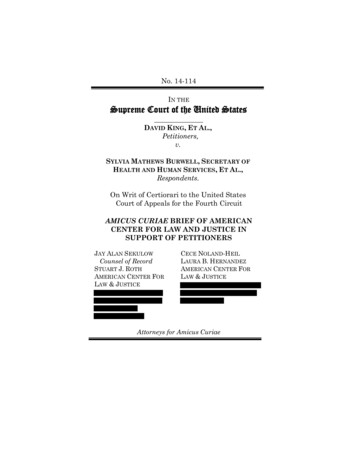
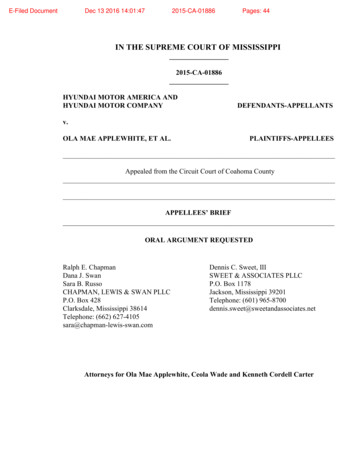
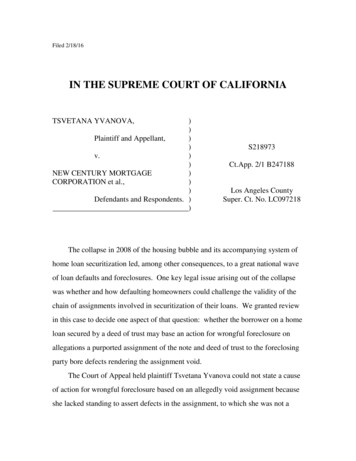
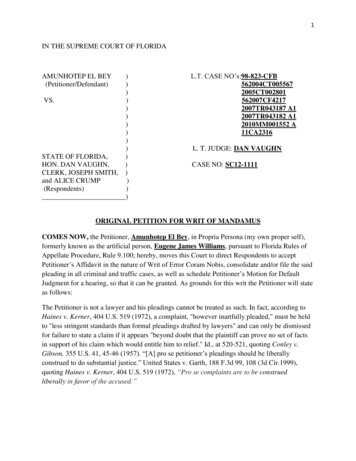
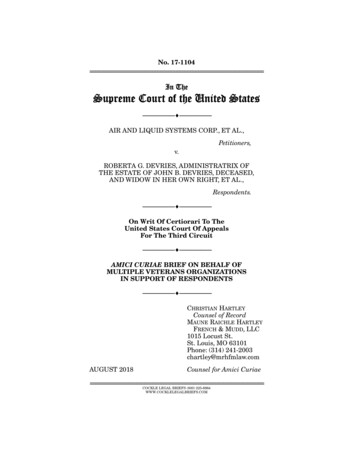
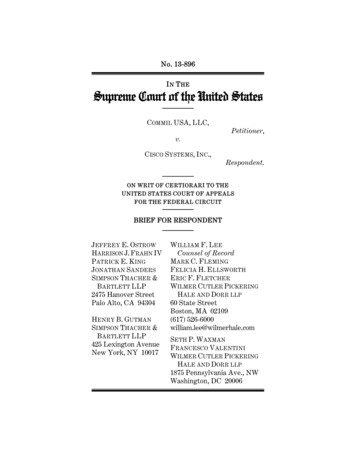
![IN THE SUPREME COURT OF T]-lE STATE OF MONTANA](/img/7/526b198c923f8.jpg)
